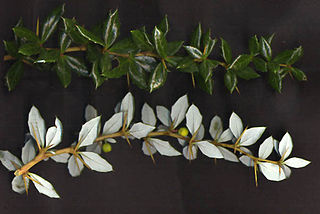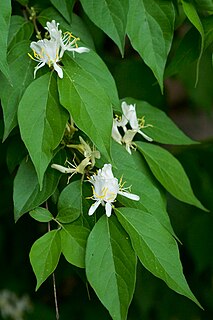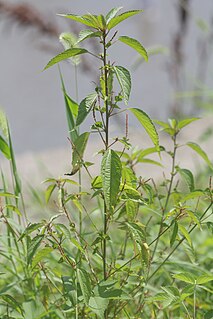
Carl Johann Maximovich was a Russian botanist. Maximovich spent most of his life studying the flora of the countries he had visited in the Far East, and naming many new species. He worked at the Saint Petersburg Botanical Gardens from 1852 as curator of the herbarium collection, becoming Director in 1869.

Berberis, commonly known as barberry, is a large genus of deciduous and evergreen shrubs from 1–5 m (3.3–16.4 ft) tall, found throughout temperate and subtropical regions of the world. Species diversity is greatest in South America and Asia; Europe, Africa and North America have native species as well. The best-known Berberis species is the European barberry, Berberis vulgaris, which is common in Europe, North Africa, the Middle East, and central Asia, and has been widely introduced in North America. Many of the species have spines on the shoots and along the margins of the leaves.

Berberis verruculosa, the warty barberry or warted barberry, is an evergreen shrub, ranging in size from 1–2 m, native to western China. It gets its common name from its "warty" stems, that have rounded, more or less identical, raised spots.

The Amur hedgehog, also called the Manchurian hedgehog, is a hedgehog similar to the European hedgehog in appearance and behaviour, although it is more lightly coloured. It is native to Amur Oblast and Primorye in Russia, Manchuria in China, and the Korean Peninsula. Like other hedgehogs, it uses scent and hearing while looking for prey, and the name "hedgehog" refers to the pig-like grunts it makes as it forages.

Vitis amurensis, the Amur grape, is a species of grape native to the Asian continent. Its name comes from the Amur Valley in Russia and China.

Berberis darwinii, Darwin’s barberry, is a species of barberry in the family Berberidaceae, native to southern Chile and Argentina and naturalized elsewhere. Vernacular names include michay, calafate, and quelung.
Atractylodes is a genus of Asian flowering plants in the sunflower family.

Asterias amurensis, also known as the Northern Pacific seastar and Japanese common starfish, is a seastar found in shallow seas and estuaries, native to the coasts of northern China, Korea, far eastern Russia, Japan, Alaska, the Aleutian Islands and British Columbia in Canada. Two forms are recognised: the nominate and formarobusta from the Strait of Tartary. It mostly preys on large bivalve molluscs, and it is mostly preyed on by other species of starfish. Population booms in Japan can affect the harvest of mariculture operations and are costly to combat.

Lonicera maackii, the Amur honeysuckle, is a species of honeysuckle in the family Caprifoliaceae that is native to temperate western Asia, specifically in northern and western China south to Yunnan, Mongolia, Primorsky Krai in southeastern Russia, Korea, and, albeit rare there, central and northern Honshū, Japan.

Abies nephrolepis, commonly known as Khingan fir, is a species of fir native to northeastern China, North Korea, South Korea, and southeastern Russia.

Syringa reticulata is a species of Lilac, native to eastern Asia: in northern Japan, northern China, Korea, and far southeastern Russia (Primorye).

Acalypha australis, commonly known as Asian copperleaf, is a species of flowering plant in the family Euphorbiaceae native to eastern Asia.

Mahonia duclouxiana is a plant species native to India, Myanmar (Burma), Thailand, and southern China.

Allium sacculiferum, also called northern plain chive or triangular chive, is an East Asian species of wild onion native to Japan, Korea, eastern Russia, and northeastern China. It is found along the banks of lakes and rivers at elevations less than 500 m.

Berberis aggregata, the clustered barberry, is a shrub native to western China. It grows at elevations of 1000–3500 m.
Berberis amabilis is a shrub native to Yunnan and Myanmar (Burma). It grows at elevations of 1800–3300 m.
Berberis sikkimensis is a plant species native to the high Himalayas at elevations of 2000–3000 m. It is known from Sikkim, Nepal, Bhutan, Tibet and Yunnan.
Phyllospadix japonicus, known as Asian surfgrass, is a plant species found along the seacoasts of Japan, Korea, China. It occurs in the intertidal zone along the shore.

Acer barbinerve, commonly known as bearded maple, is an Asian species of maple found in Korea, eastern Russia, and northeastern China.

Adonis amurensis, commonly known as Amur adonis and pheasant's eye, is a perennial plant with a golden yellow flower belonging to the Ranunculales order, and native to China, Japan (Hokkaido), Korea, and Russian Far East. The Japanese name Fukujusō means fortune-longevity-plant.















